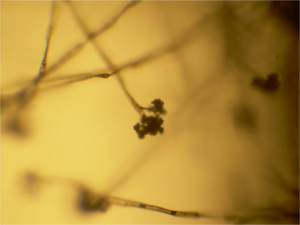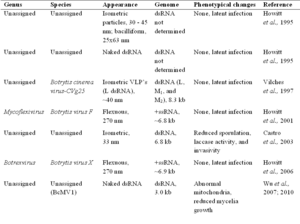Botrytis cinerea facts for kids
Quick facts for kids Botrytis cinerea |
|
|---|---|
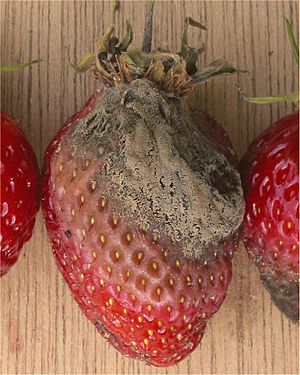 |
|
| Botrytis cinerea infection on strawberry | |
| Scientific classification | |
| Genus: |
Botrytis
|
| Species: |
cinerea
|
Botrytis cinerea is a type of fungus that causes plants to rot. It's often called "grey mould" because of its fuzzy, grey appearance. This fungus can infect many different plants, but it's especially well-known for affecting wine grapes.
On grapes, Botrytis cinerea can cause two very different things. If the weather stays wet and humid, it leads to "grey rot," which ruins the grapes. But if wet conditions are followed by drier ones, it can create something special called noble rot. This noble rot helps make unique, sweet dessert wines, like Sauternes. The name Botrytis cinerea comes from Latin words meaning "grapes like ashes." This refers to how the fungus's spores clump together like grapes and have a grey, ash-like color.
Contents
What is Botrytis?
The name "Botrytis" comes from the Ancient Greek word botrys, which means "grapes." The ending -itis is often used in New Latin to mean a disease. So, Botrytis literally means "grape disease."
What Plants Does Grey Mould Affect?
Many Plants Can Get Grey Mould
Grey mould disease affects over 200 different types of plants, mostly those with two seed leaves (called dicotyledons). It can also affect some plants with one seed leaf (called monocotyledons). This disease is found in many parts of the world, especially in places with mild or warm climates.
Botrytis cinerea can cause big problems for farmers, leading to a lot of lost crops. It can infect plants in fields or in greenhouses. It attacks many kinds of crops, including:
- Vegetables like chickpeas, lettuce, broccoli, and beans.
- Small fruits like grapes, strawberries, raspberries, and blackberries.
The fungus can damage fruits, flowers, leaves, storage parts (like bulbs), and shoots of plants.
How to Spot Grey Mould
The signs of grey mould can look different depending on which part of the plant is infected.
- On soft fruits and leaves, it looks like a soft, watery rot.
- Undeveloped fruits might slowly get brown spots.
- Twigs that are infected will die back.
- Infected blossoms can cause fruits to drop off or develop oddly.
You often see symptoms where the plant has been wounded, as the fungus starts to rot the plant from there. A clear sign of the fungus is fuzzy, grey patches that look like velvet. These patches are made of tiny spores. These spores can spread easily and infect other parts of the plant or nearby plants throughout the growing season.
When a plant is attacked, it can try to protect itself by causing some of its cells to die. This is called a hypersensitive response. However, Botrytis cinerea is a "necrotrophic" pathogen, meaning it likes to feed on dead tissue. So, it can actually use this plant defense to help itself spread! Plants that are easily infected by B. cinerea cannot use this defense to stop the fungus.
How Does Grey Mould Live and Spread?
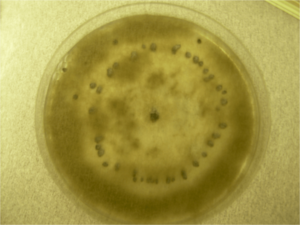
Botrytis cinerea produces many clear spores on grey, branching structures called conidiophores. The fungus also makes tough, dark brown balls called sclerotia. These sclerotia help the fungus survive tough conditions, like winter.
In spring, the sclerotia or leftover mycelia (the main body of the fungus) start to grow and produce new conidiophores. The tiny spores are then carried by wind and rain, causing new infections. Botrytis cinerea can keep spreading and infecting plants all summer long.
A different fungus called Gliocladium roseum can actually act as a parasite to B. cinerea, which is interesting!
What Conditions Does Grey Mould Like?
Grey mould loves moist, humid, and warm conditions, especially temperatures between 18-24°C (65-75°F). When there's enough moisture and warmth, the fungus's mycelium or spores can easily start new infections. Greenhouses, where crops are grown in controlled environments, often have the perfect warm and moist conditions for B. cinerea to spread.
- Water on Leaves: Standing water on plant leaves gives the spores a great place to start growing.
- Humidity: High humidity can happen if plants are too close together, if irrigation isn't done properly, or if a greenhouse doesn't have good air circulation.
- Ventilation: Letting fresh air circulate, especially at night, can greatly reduce how much grey mould appears.
The tough, dark sclerotium of B. cinerea can survive in the soil for years. Both these sclerotia and the asexual spores help the pathogen spread widely.
Botrytis cinerea also prefers a low pH (acidic environment). It can make its surroundings more acidic by releasing special acids. This helps the fungus break down plant cell walls and makes it easier for the fungus to cause disease.
Grey Mould and Grapes: Good Rot vs. Bad Rot
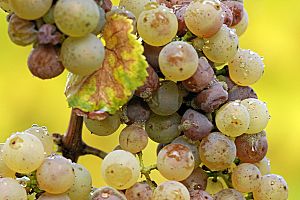
Noble Rot: The Good Kind
In the wine world, when Botrytis causes "noble rot" (called pourriture noble in French), it's a good thing! The fungus gently removes water from the grapes. This leaves behind a higher amount of sugars, fruit acids, and minerals, making the grape juice more concentrated and flavorful. The wine made from these grapes often tastes intensely sweet and can have a honey-like smell.
Noble rot happens naturally when the right mix of soil, climate, and weather conditions come together. For example, the famous Chateau d'Yquem winery is known for its sweet wines because its vineyards are very good at getting noble rot.
However, Botrytis can make the winemaking process tricky. It produces a natural chemical that can kill yeast, which is needed for fermentation. This can sometimes stop the fermentation process before the wine has enough alcohol.
Bunch Rot: The Bad Kind
"Botrytis bunch rot" is the bad side of B. cinerea for grapes. This type of rot causes big losses for winemakers. The fungus is often present on grapes, but it usually needs a wound to start a full infection. These wounds can come from insects, wind, or accidental damage.
To control bunch rot, farmers can use special fungicides. These are often applied when the grapevines are flowering, when the bunches close up, and when the grapes start to change color. Some winemakers might even allow a small amount of bunch rot (around 5%) in their grapes, sometimes leaving them on the vine a week longer than usual to achieve a certain flavor.
Grey Mould and Other Plants
Strawberries
Botrytis cinerea causes big economic problems for soft fruits like strawberries and for bulb crops. Unlike grapes with noble rot, strawberries affected by grey mould are not safe to eat and must be thrown away. To help prevent infection in strawberry fields, it's important to have good air circulation around the berries. This stops moisture from getting trapped among the leaves and fruits. Some helpful bacteria have also been shown to fight B. cinerea in studies.
Other Affected Plants
In greenhouses, Botrytis cinerea is known to cause a lot of damage to tomatoes. It also affects plants like rhubarb, snowdrops, white meadowfoam, western hemlock, Douglas-fir, and lettuce. Scientists have found that treating lettuce with UV-C light can make the plant more resistant to B. cinerea by boosting its natural defenses. Some farmers also use fungicides made from potassium bicarbonate.
Can Grey Mould Affect Humans?
Yes, in rare cases, mold from Botrytis cinerea on grapes can cause a lung condition called "winegrower's lung." This is a type of hypersensitivity pneumonitis, which is an allergic reaction in the lungs that can happen to people who are sensitive to the mold.
Tiny Viruses Inside the Fungus
Just like plants can get sick from fungi, Botrytis cinerea itself can be infected by tiny viruses called mycoviruses! These viruses can change how the fungus behaves. Sometimes they have no effect, but other times they can make the fungus grow slower, produce fewer spores, or even become less harmful to plants.
How to Manage Grey Mould
Farmers and gardeners can manage Botrytis cinerea using several methods:
- Cultural Practices: These are ways of growing plants that make it harder for the fungus to spread.
- No plant species are completely resistant to grey mould.
- Avoid using too much nitrogen fertilizer, as this can increase the disease.
- Choose plant types that don't grow too densely, as dense growth limits airflow.
- Space plants far enough apart so they don't touch, which helps air circulate and keeps the area dry.
- Regularly prune (trim) dead, diseased, or overgrown parts of plants to improve air movement.
- Clean up dead or dying plant material in the fall and spring. This removes places where the fungus can survive winter.
- During harvest, throw away any berries that show signs of grey mould to reduce the amount of fungus for the next year.
- Adding a type of charcoal called Biochar to the soil can help strawberry plants fight off the fungus by boosting their natural defenses.
- Chemical Control: Farmers can use fungicides to control grey mould. It's important to apply these at the right time, like during the first bloom, to prevent the fungus from becoming resistant and to save costs. However, the fungus can sometimes become resistant to multiple fungicides, which makes it harder to control.
- Biological Control: This involves using other living things to fight the fungus. For example, certain fungi like Trichoderma harzianum and Clonostachys rosea have been successfully used in Europe and Brazil to suppress grey mould.
See also
 In Spanish: Botrytis cinerea para niños
In Spanish: Botrytis cinerea para niños


